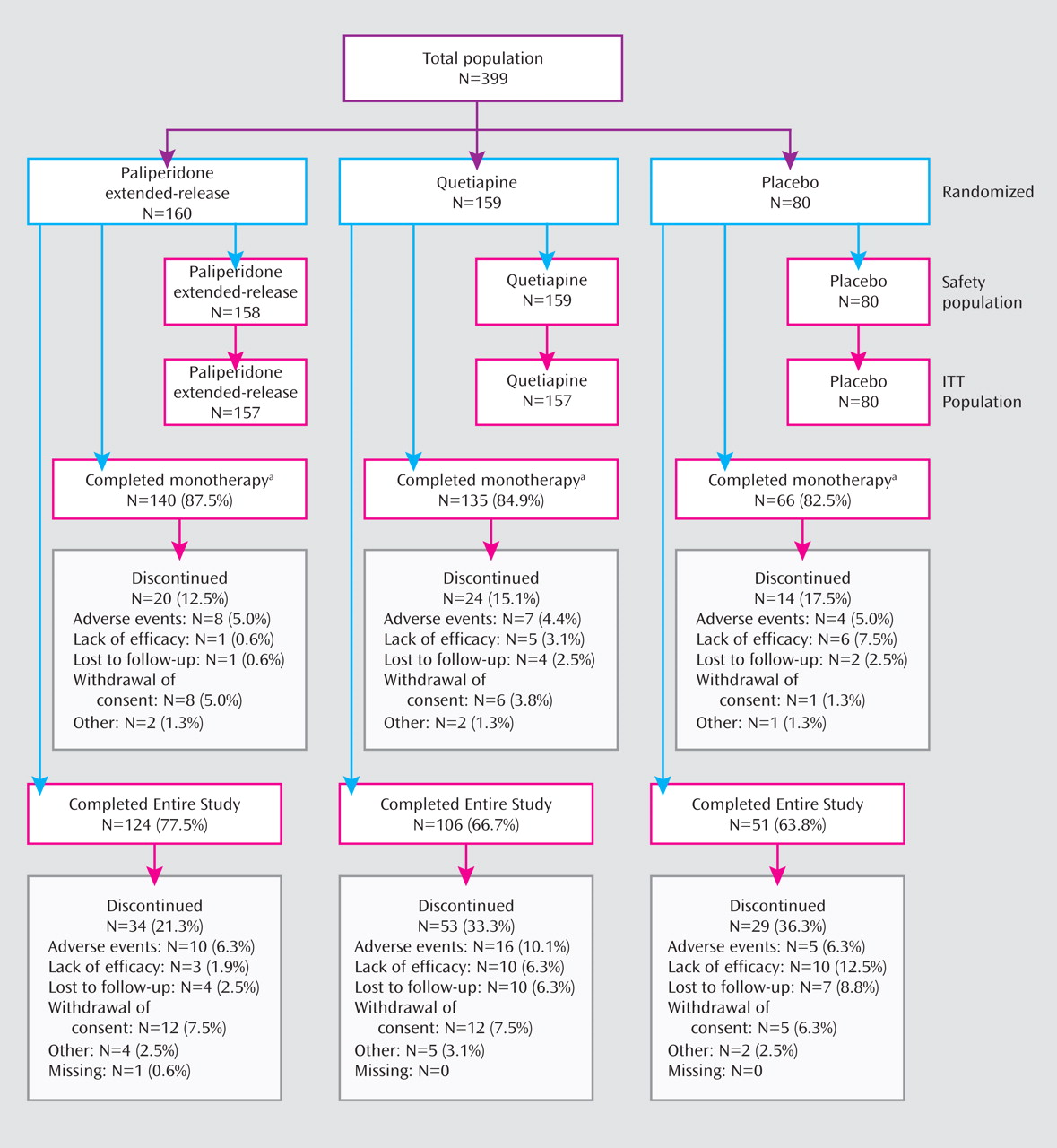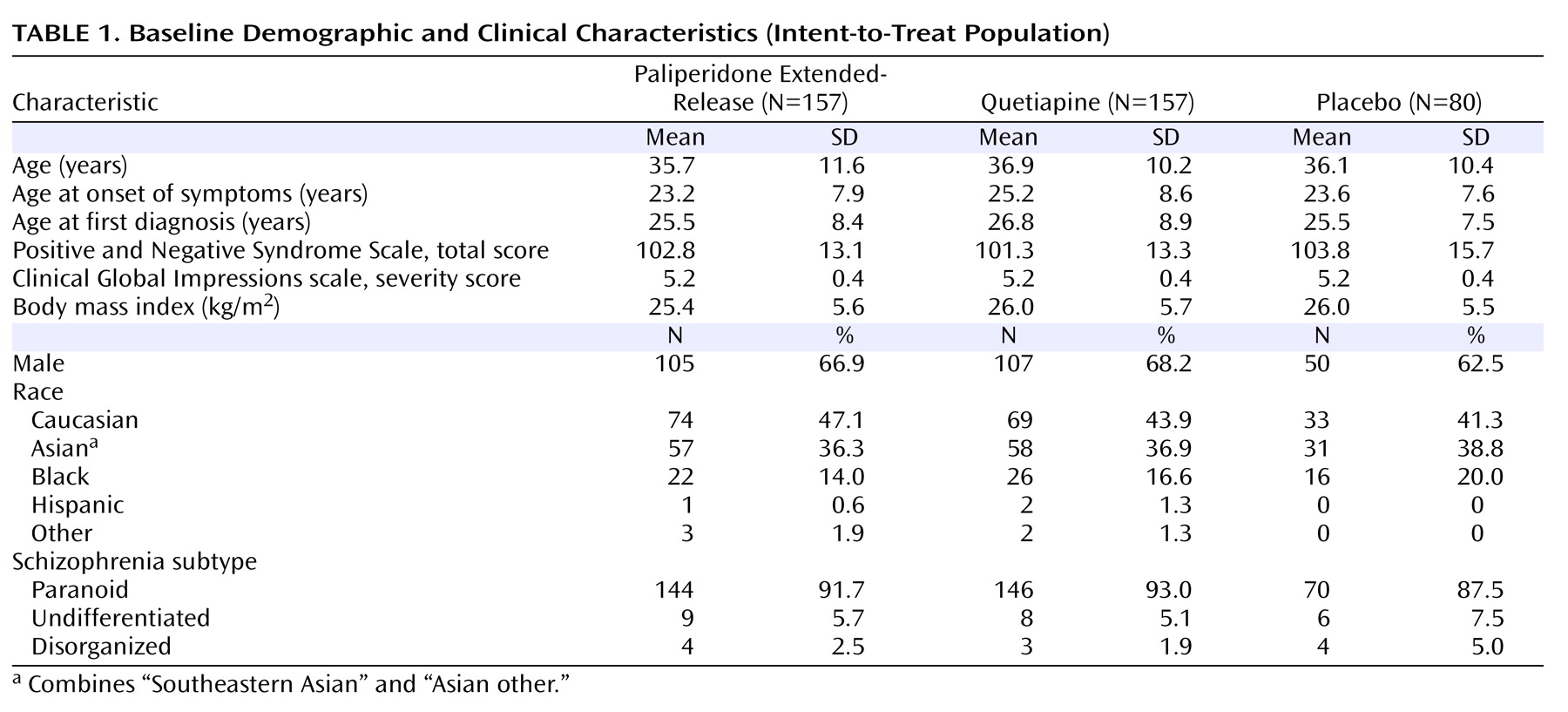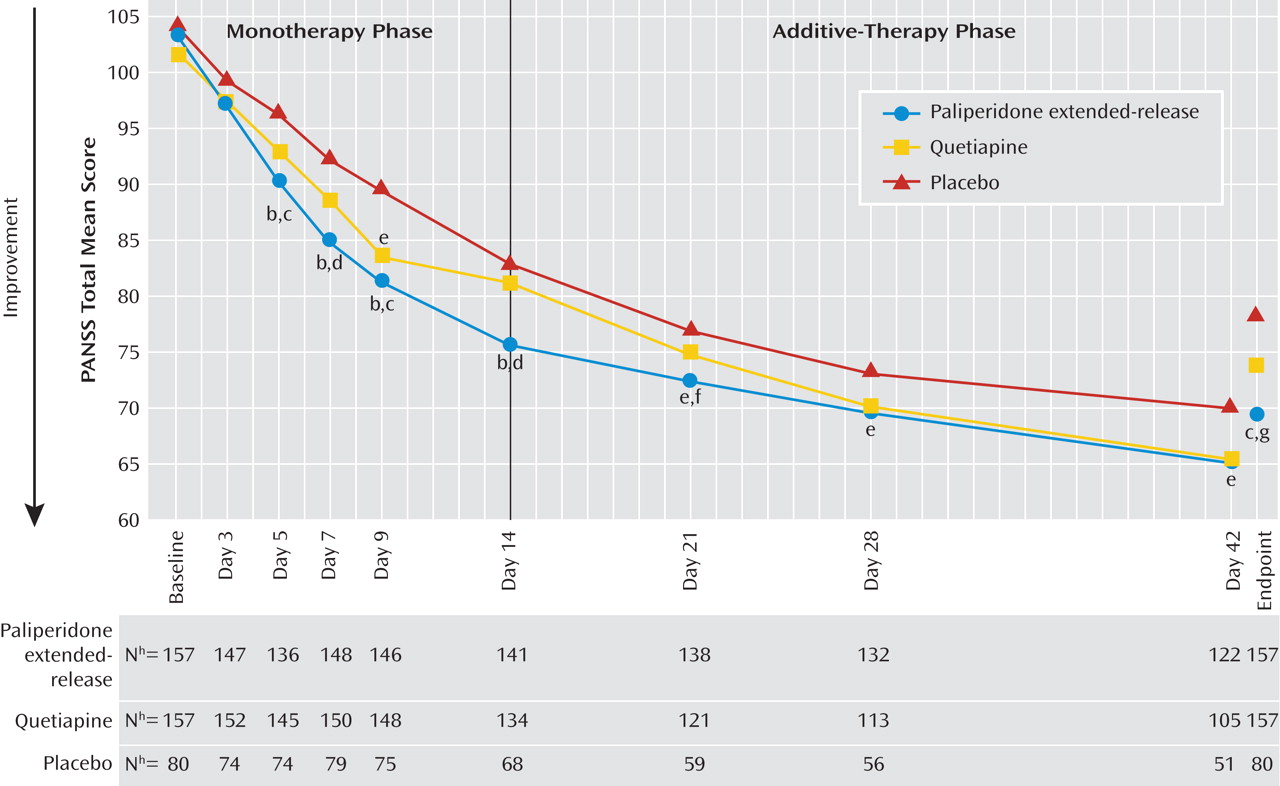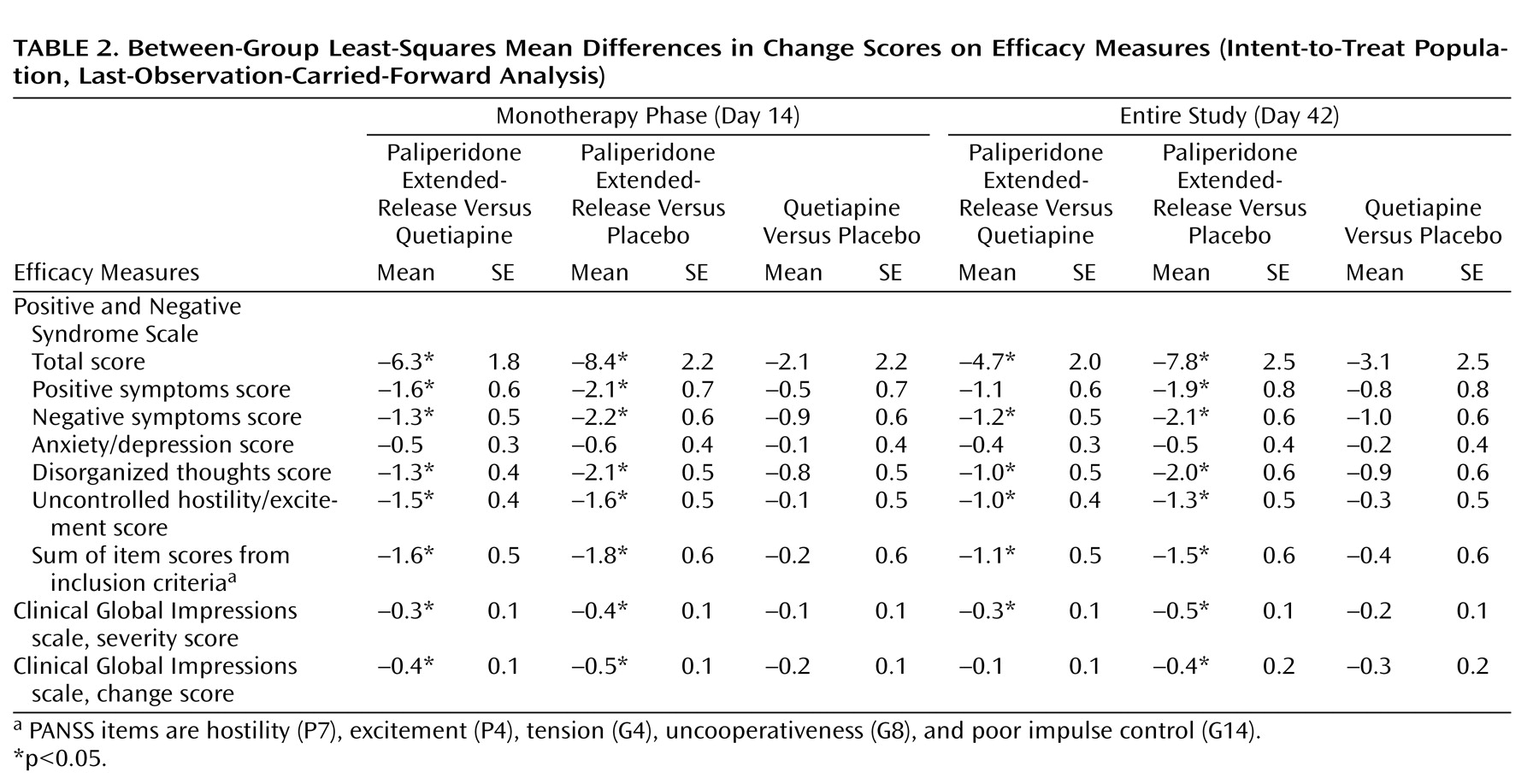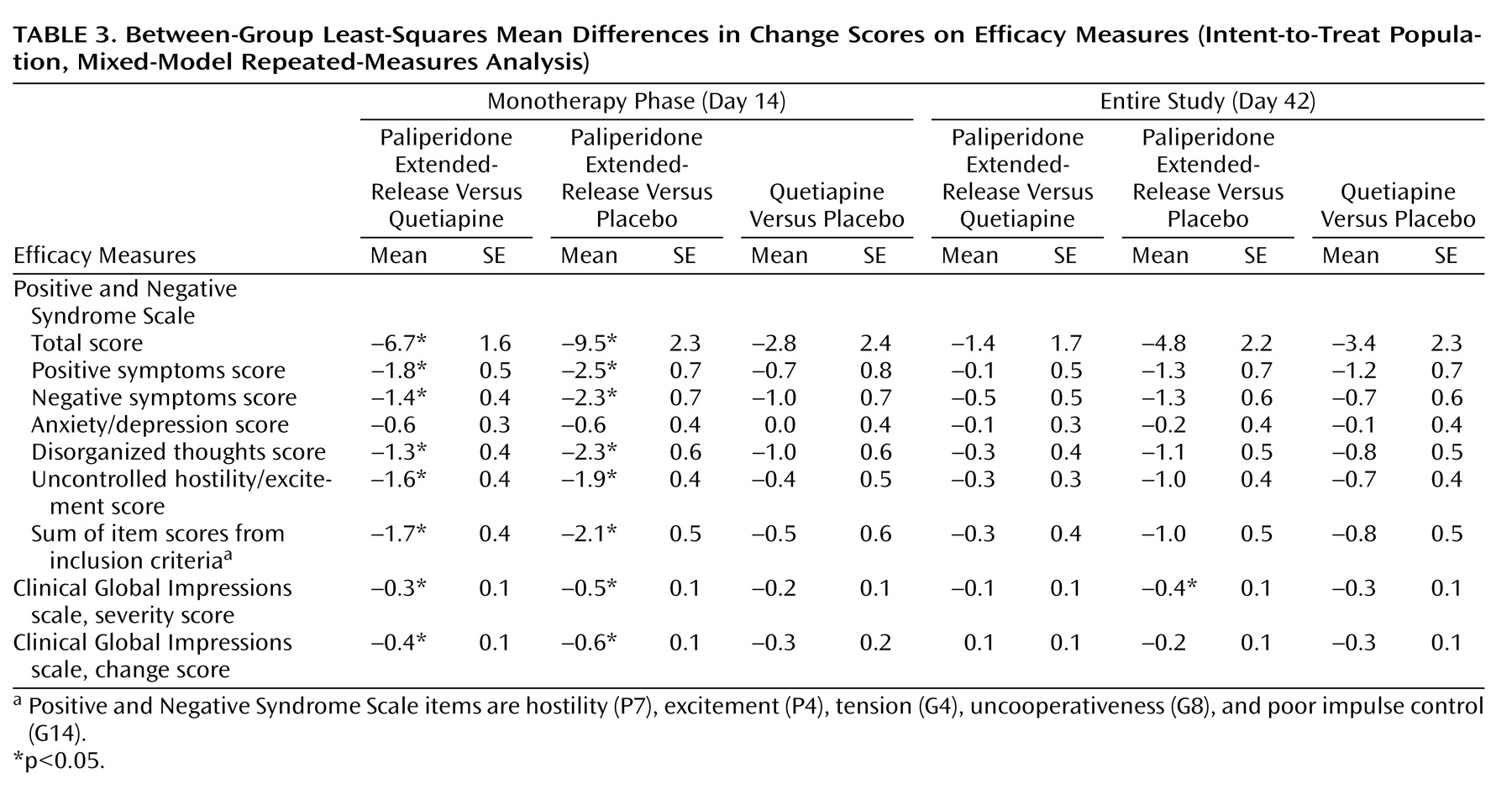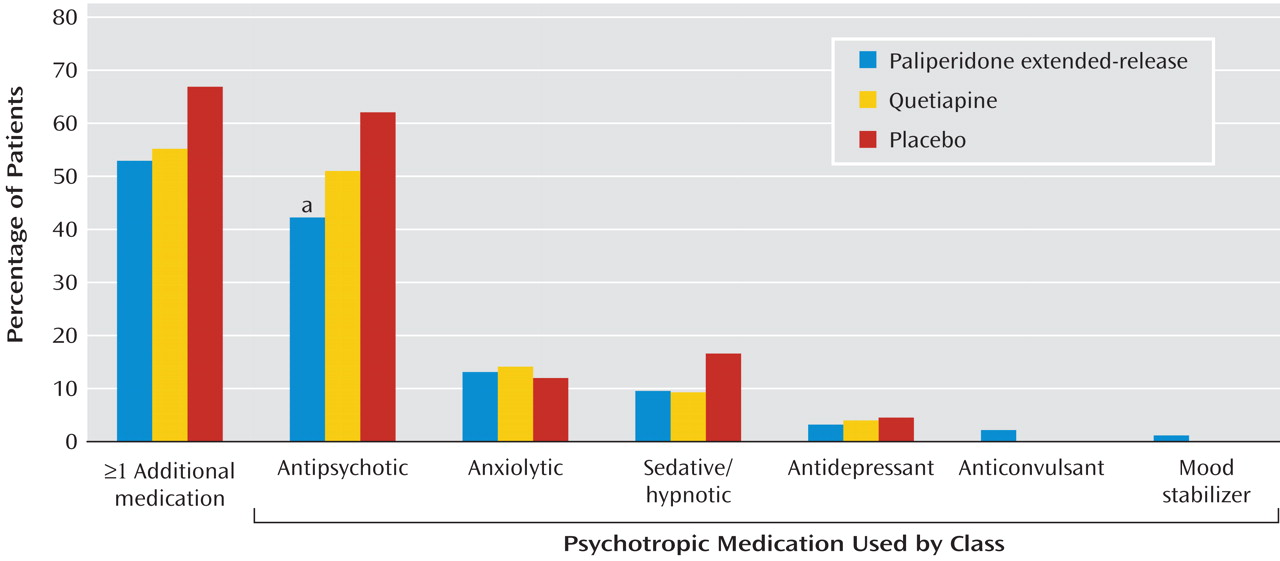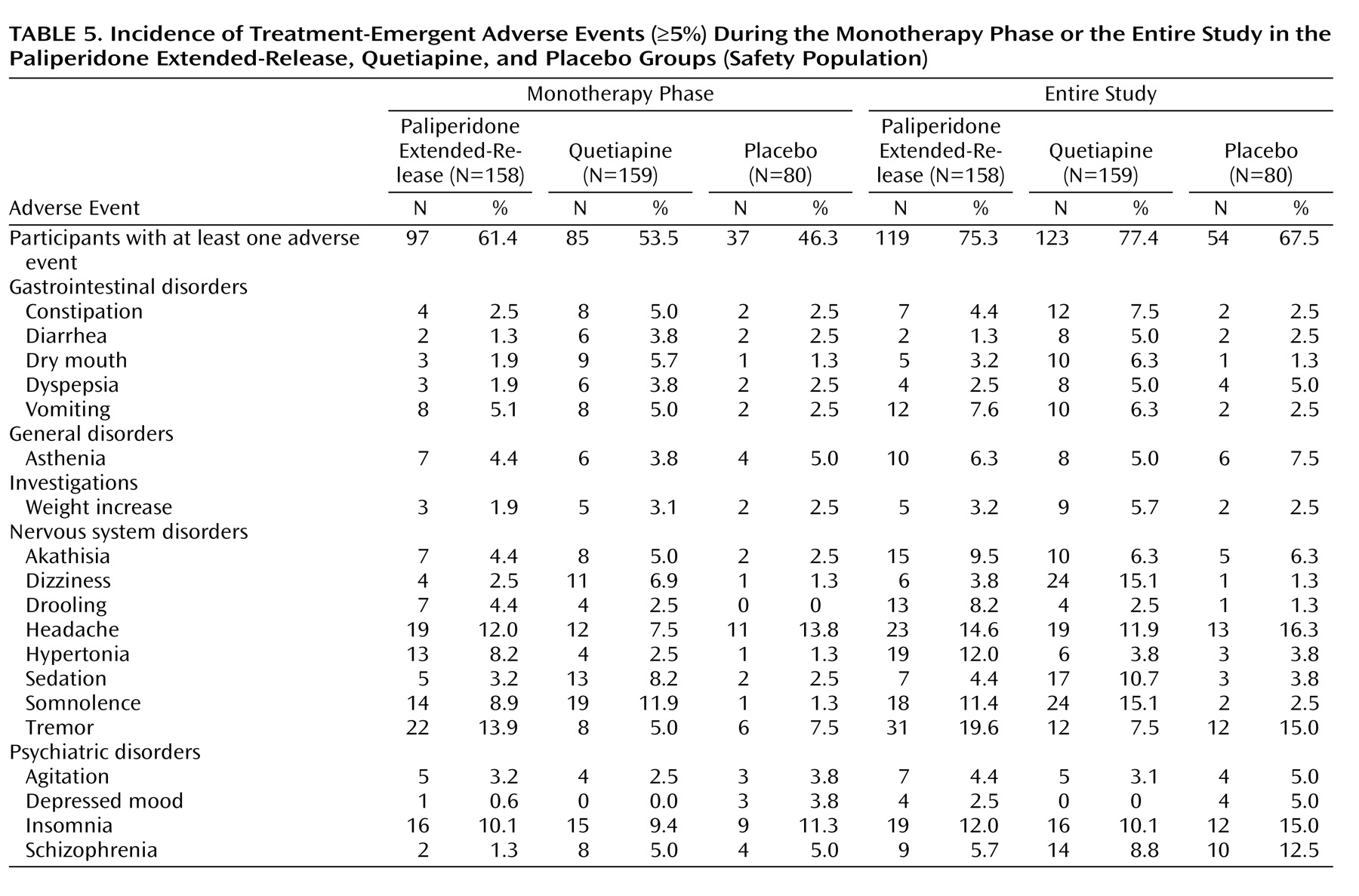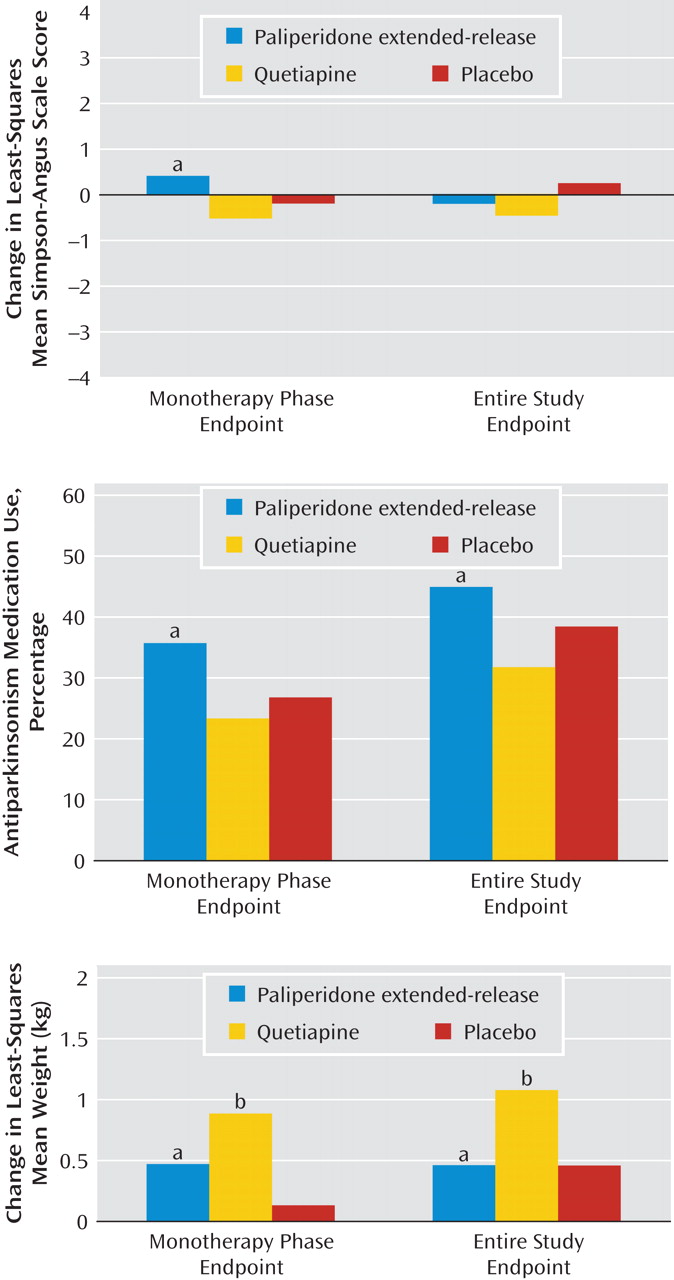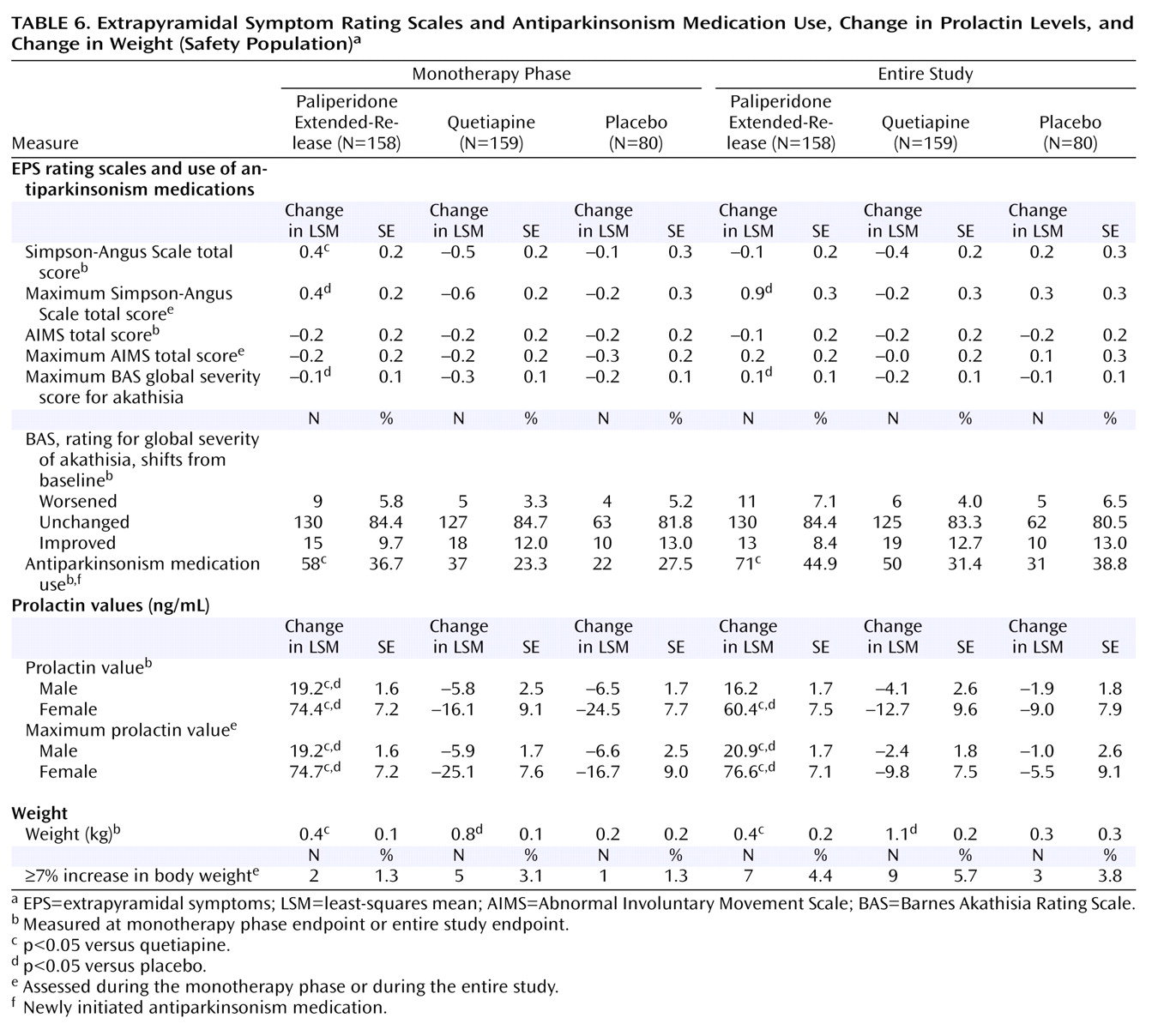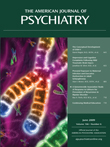The atypical antipsychotic paliperidone extended-release, approved for the treatment of schizophrenia, has demonstrated a rapid onset of efficacy in clinical studies (beginning at the first observation point on day 4)
(4 –
7), which suggests that it may be particularly useful for acutely ill patients requiring hospitalization. Paliperidone extended-release is an osmotically released oral formulation that minimizes peak-to-trough fluctuation and allows initiation at a once-daily therapeutic dose
(8) without the need for dose titration. The parent molecule, risperidone, which may necessitate titration and twice-daily dosing, has shown greater efficacy than quetiapine (another atypical antipsychotic) and placebo in a study of acutely ill hospitalized patients
(9) . In contrast to risperidone and other antipsychotics, paliperidone extended-release undergoes limited hepatic metabolism, with minimal involvement of the cytochrome P450 2D6 and 3A4 pathways and a low likelihood of hepatically mediated drug-drug interactions in patients receiving combination therapy
(10,
11) .
This trial compared the short-term efficacy and safety of paliperidone extended-release and quetiapine in hospitalized patients with a recent exacerbation. It included a more naturalistic phase mirroring clinical practice to explore the use and effects of combination therapy, including additional antipsychotics.
Method
Design
This was a randomized, double-blind, placebo-controlled 6-week trial with two phases: a 2-week monotherapy phase followed by a 4-week additive-therapy phase during which participants could receive additional psychotropic medications, including antipsychotics. The trial was conducted in inpatient settings in India, Russia, the Ukraine, and the United States from May 2006 to July 2007, in accordance with current International Conference on Harmonization-Good Clinical Practice guidelines and the Declaration of Helsinki. Each participant provided written informed consent; patients who were unable to do so or who were involuntarily committed could not be enrolled.
Participants
Patients were 18 to 65 years of age and had a diagnosis of schizophrenia (paranoid, disorganized, or undifferentiated types) according to DSM-IV criteria and confirmed by the Mini-International Neuropsychiatric Interview–Plus Version
(12) . Patients had been experiencing an acute exacerbation for less than 4 weeks but more than 4 days and had symptom scores ≥4 (at least moderate) on at least two of the Positive and Negative Syndrome Scale (PANSS)
(13) items of hostility, excitement, tension, uncooperativeness, and poor impulse control, and a total combined score ≥17 for these items. Patients had a score ≥5 (at least markedly ill) on the severity scale of the Clinical Global Impressions scale
(14) and were hospitalized or required hospitalization.
Exclusion criteria were a DSM-IV axis I diagnosis (except for schizophrenia and substance abuse); an axis II diagnosis of mental retardation or borderline personality disorder; acute psychotic symptoms explained by substance use or medical illness; evidence for imminent risk of self-harm; a history of treatment resistance; treatment with quetiapine, paliperidone extended-release, or risperidone for 7 or more days prior to assessment for study entry; sensitivity to paliperidone extended-release, risperidone, or quetiapine; depot antipsychotic treatment within one cycle before baseline; and ECT within 3 months of entry. Participants were hospitalized for a minimum of 10 days.
Study Medication
At baseline (day 0), participants discontinued all psychotropic medications. On day 1, participants were randomly assigned in a 2:2:1 ratio to treatment with paliperidone extended-release, quetiapine, or placebo. The randomization was stratified by site in blocks of five, and assignments were made using an interactive voice response system. All medication was blinded and identically overencapsulated, including placebo.
Dosing was based on the anticipated needs of an acutely exacerbated population likely to benefit from doses near the upper end of recommended ranges, with a more aggressive titration schedule for both antipsychotics. Paliperidone extended-release was initiated at 6 mg (days 1–3) and increased to 9 mg at day 4, with an optional increase to 12 mg at day 8. In accordance with labeling, quetiapine was initiated at 50 mg/day on day 1. The dose was doubled to 100 mg/day on day 2, to 200 mg/day on day 3, to 400 mg/day on day 4, and to 600 mg on day 5; an optional dose increase to 800 mg/day was permitted on day 8. During the additive-therapy phase, patients continued on the dose received at day 14.
Concomitant Medications
Use of other psychotropic medications was prohibited during the monotherapy phase, except for injectable lorazepam, amobarbital sodium, or midazolam as needed for severe agitation or restlessness; zaleplon, zopiclone, or zolpidem for insomnia; and benztropine mesylate or equivalent treatments for movement disorders.
During the additive-therapy phase, any psychotropic medication, including antipsychotics, was permitted, except for risperidone, additional paliperidone extended-release or quetiapine, and other specifically prohibited medications: drugs that interact with P450 isoenzyme CYP3A4 (by which quetiapine is metabolized), lithium (because of potential effects on thyroid function), herbal/over-the-counter medications that have psychotropic effects, and drugs that prolong the QTc interval.
Outcome Measures
Efficacy was assessed by the PANSS
(13,
15), the severity and change scores of the Clinical Global Impressions scale (CGI-S and CGI-C, respectively)
(14), and a composite response measure (a PANSS total score reduction ≥30% and a CGI-C score of 1 or 2 [very much or much improved]). Assessments were performed at baseline (except for the CGI-C), on days 3, 5, 7, 9, 14, 21, 28, and 42, and at endpoint. The Readiness for Discharge Questionnaire
(16), a validated instrument providing a dichotomous (yes/no) assessment of readiness for discharge based on behavioral and functional status, was completed on days 3, 5, 7, 9, 14, and 21. The Medication Satisfaction Questionnaire, a patient-reported 7-point Likert-type scale ranging from 1 (extremely dissatisfied) to 7 (extremely satisfied), was completed on days 14 and 42. Use of additional psychotropic medication was recorded. Treatment-emergent adverse events and vital signs were monitored and recorded at each visit. Laboratory tests (hematology, biochemistry studies, prolactin levels, thyroid function tests, and urinalysis) and ECG were conducted on days 0, 14, and 42. Movement disorders were assessed on days 0, 14, and 42 using the Simpson-Angus Rating Scale
(17), the Barnes Rating Scale for Drug-Induced Akathisia
(18), and the Abnormal Involuntary Movement Scale (AIMS)
(19) .
Statistical Analysis
Based on previous studies of paliperidone extended-release and quetiapine
(4 –
6,
9), a sample of 134 patients in each active-treatment group was anticipated to have ≥90% power to detect an effect size of 0.4 in PANSS total change at day 14, with an assumption of equal variance at a 0.05 two-sided significance level. With a 2:2:1 randomization ratio for the paliperidone extended-release, quetiapine, and placebo groups, respectively, an estimated total of 335 subjects was required; assuming 15% attrition at day 14, the trial required a total of 395 patients in the randomization process.
Efficacy measures were analyzed in the intent-to-treat population, defined as patients who underwent the randomization process and took at least one dose of study medication and had at least one postbaseline efficacy evaluation. Safety parameters were analyzed in all enrolled patients who took at least one dose of study medication.
The primary outcome measure was change in PANSS total score from baseline to monotherapy phase endpoint (day 14). Based on this outcome measure, the primary comparison was between paliperidone extended-release and quetiapine. Analysis of covariance (with treatment and site as factors and baseline scores as covariates) was used for between-group comparisons, with a last-observation-carried-forward approach for missing postbaseline observations. A mixed-model repeated-measures analysis was prespecified for the primary outcome measure and was also conducted for all continuous secondary measures to examine the robustness of the last-observation-carried-forward results. A sensitivity analysis excluded one site because of compliance deficiencies in Good Clinical Practice standards. Results are reported as least-squares means, which are means that have been adjusted for imbalances in multiple factors. Categorical values were analyzed using the Cochran-Mantel-Haenszel chi-square test, controlling for site. All-cause discontinuation was summarized using Kaplan-Meier product-limit survival curve estimates and an unstratified log-rank test for treatment group comparisons. The 2-week endpoint is referred to as the monotherapy phase endpoint, and the 6-week endpoint as the study endpoint.
Results
A total of 399 patients were randomly assigned to treatment with paliperidone extended-release, quetiapine, or placebo (
Figure 1 ). Baseline demographic characteristics were comparable among groups. Baseline mean PANSS total scores were >100, reflecting high symptom severity in this population (
Table 1 ).
Monotherapy Phase (Days 1–14)
Completion rates during the monotherapy phase were 87.5%, 84.9%, and 82.5% in the paliperidone extended-release, quetiapine, and placebo groups, respectively (see
Figure 1 ). The last mean daily doses during monotherapy were 10.4 mg (SD=1.7) for paliperidone extended-release and 690.9 mg (SD=134.3) for quetiapine. The last-observation-carried-forward analysis demonstrated that improvement was greater with paliperidone extended-release than quetiapine in least-squares mean PANSS total change score from day 5 (–11.4 [SE=1.1] and –8.2 [SE=1.1], p=0.011) through the 2-week monotherapy phase endpoint (–23.4 [SE=1.8] and –17.1 [SE=1.8], p<0.001) (
Figure 2 ). Patients in the paliperidone extended-release group showed greater PANSS improvement than those in the placebo group from day 5 through monotherapy phase endpoint (p≤0.001), whereas quetiapine separated from placebo only at day 9. These findings were consistent with those resulting from the mixed-model repeated-measures method (see Tables
2 and
3 for comparison) as well as with the analysis excluding the site deficient in Good Clinical Practice standards.
At monotherapy phase endpoint, least-squares mean changes on four of five PANSS factors (negative symptoms, positive symptoms, disorganized thoughts, and hostility/excitement) were greater with paliperidone extended-release than with quetiapine and placebo (p≤0.008). Changes were similar for quetiapine and placebo on PANSS factor scores. Findings were similar for the change in the sum of the five PANSS items that were part of the inclusion criteria (
Table 2 ).
On the CGI-S and CGI-C, paliperidone extended-release was better than both quetiapine (p=0.002) and placebo (p<0.001), whereas quetiapine did not separate from placebo at the 2-week monotherapy phase endpoint (
Table 2 ). Least-squares mean changes on the Medication Satisfaction Questionnaire were also greater with paliperidone extended-release (4.9 [SE=0.1]) than with quetiapine (4.5 [SE=0.2], p=0.006) or with placebo (4.6 [SE=0.2], p=0.030), whereas mean changes with quetiapine and placebo were similar (n.s.). A comparable proportion of patients achieved a composite response with paliperidone extended-release and quetiapine (40.1% and 31.2%, respectively; n.s.); however, although paliperidone extended-release was better than placebo (27.5%, p=0.022), the proportion of patients having a composite response with quetiapine or placebo was similar (n.s.). The readiness for discharge rate was 50.6% with paliperidone extended-release, compared with 43.3% with quetiapine (n.s.). Whereas more patients were ready for discharge with paliperidone extended-release than with placebo (37.5%, p=0.027), rates were similar between quetiapine and placebo (n.s.). Results for the continuous secondary measures assessed by mixed-model repeated measures were comparable (see Tables
2 and
3 for comparison).
The proportions of patients taking medication for insomnia or agitation during the monotherapy phase were 44.3%, 38.4%, and 41.2% in the paliperidone extended-release, quetiapine, and placebo groups, respectively (no significant differences between groups).
Entire Study (Monotherapy Phase Days 1–14 Plus Additive-Therapy Phase Days 15–42)
The all-cause discontinuation rate (Kaplan-Meier estimate) was lower for paliperidone extended-release (21.5%) than for quetiapine (33.3%, p=0.036) and placebo (36.3%, p=0.032); it was similar for quetiapine and placebo (n.s.). Discontinuation rates owing to lack of efficacy were 1.9% with paliperidone extended-release, 6.3% with quetiapine, and 12.5% with placebo (
Figure 1 ). The mean daily doses were paliperidone extended-release 9.8 (SD=1.5) mg and quetiapine 599.1 (SD=142.0) mg.
The treating physician could add psychotropic medications, including other antipsychotics, after day 14 to optimize treatment response. Similar proportions of patients receiving paliperidone extended-release (52.9%) or quetiapine (55.4%) received one or more additional psychotropic medications during the additive-therapy phase; 66.7% received psychotropic medications in the placebo group. Additive-therapy use by class is provided in
Figure 3 and
Table 4 . The only between-group difference in additive therapy was that a lower proportion of paliperidone extended-release patients relative to placebo patients received additional antipsychotic medication. Olanzapine and haloperidol were the most commonly prescribed adjunctive antipsychotics across all groups.
Although combination therapy in the paliperidone extended-release and quetiapine groups was similar, several between-group efficacy differences persisted. Improvement in the least-squares mean PANSS total score change at study endpoint was greater with paliperidone extended-release than with quetiapine (p=0.023) or placebo (p=0.002); change with quetiapine was similar to that with placebo (n.s.) (
Table 2,
Figure 2 ). These between-group changes observed over the entire study period appear to be due largely to changes during the monotherapy phase; least-squares mean PANSS total score change observed during the additive-therapy phase only was not significantly different between groups (paliperidone extended-release, –8.8 [SE=1.1]; quetiapine, –10.2 [SE=1.2]; placebo, –8.9 [SE=1.6]).
Over the entire study, there was greater improvement with paliperidone extended-release than with quetiapine or placebo on PANSS factor scores for negative symptoms, disorganized thoughts, and uncontrolled hostility/excitement (all p values <0.050). The PANSS positive factor score improved more with paliperidone extended-release compared with placebo (p=0.014) and was similar between paliperidone extended-release and quetiapine (n.s.). Results for the sum of the five PANSS items in the inclusion criteria were consistent (
Table 2 ).
Paliperidone extended-release was significantly better than quetiapine and placebo at study endpoint on the CGI-S, whereas quetiapine did not separate from placebo on either measure (
Table 2 ). Paliperidone extended-release, but not quetiapine, was better than placebo on CGI-C scores at study endpoint, whereas scores with paliperidone extended-release compared to quetiapine were similar (
Table 2 ). Least-squares mean changes on the Medication Satisfaction Questionnaire were greater with paliperidone extended-release (5.3 [SE=0.1]) than with quetiapine (4.8 [SE=0.1], p=0.002) or with placebo (4.7 [SE=0.2]; p=0.06), whereas mean changes with quetiapine and placebo were comparable (n.s.). A similar proportion of patients achieved a composite response with paliperidone extended-release and quetiapine (65.0% and 59.9%, respectively; n.s.); however, although paliperidone extended-release was better versus placebo (50.0%, p=0.022), the proportion having a composite response with quetiapine or placebo was similar (n.s.). Results for the primary and secondary continuous measures assessed by mixed-model repeated-measures methods were comparable to those obtained with the last-observation-carried-forward approach (see Tables
2 and
3 for comparison).
Safety
Adverse event-related discontinuation rates with paliperidone extended-release, quetiapine, and placebo, respectively, were 5.0%, 4.4%, and 5.0% at the monotherapy phase endpoint and 6.3%, 10.1%, and 6.3% over the entire study period (
Figure 1 ). The most common adverse events (≥10%) during the monotherapy phase were tremor, somnolence, insomnia, and headache. The most common adverse events reported over the entire study period were tremor, somnolence, sedation, insomnia, hypertonia, dizziness, and headache (
Table 5 ).
Over the entire study period, serious adverse events were reported for 13 (8.2%) patients in the paliperidone extended-release group, seven (4.4%) in the quetiapine group, and two (2.5%) in the placebo group; the most commonly reported adverse event was schizophrenia (3.8%, 1.9%, and 0.0%, respectively, for the three groups). Most were considered unrelated to study medication. One death (cause unknown) was reported for a patient in the placebo group who had discontinued participation in the study 9 days earlier because of lack of efficacy.
Extrapyramidal symptom ratings on the Simpson-Angus Rating Scale were higher at monotherapy phase endpoint with paliperidone extended-release compared with quetiapine (p<0.001), although changes with both paliperidone extended-release and quetiapine were similar to those with placebo (
Figure 4,
Table 6 ). No significant differences were observed between groups in distribution from baseline to monotherapy phase endpoint on the global severity subscale of the Barnes Rating Scale for Drug-Induced Akathisia, nor were there between-group differences on the AIMS. At study endpoint, no significant baseline-to-endpoint differences between groups were observed for the Simpson-Angus Rating Scale, Barnes global severity subscore, or AIMS rating scales. Antiparkinsonism medication use was highest with paliperidone extended-release (
Figure 4,
Table 6 ).
Mean changes in prolactin levels at monotherapy endpoint and study endpoint were 38.4 ng/ml (SD=42.8) with paliperidone extended-release, –10.9 ng/ml (SD=33.9) with quetiapine, and –8.9 ng/ml (SD=20.6) with placebo. Changes at study endpoint for the three groups were 31.9 ng/ml (SD=40.2), –6.7 ng/ml (SD=27.1), and –4.5 ng/ml (SD=30.7), respectively. (See
Table 6 for a breakdown of the data by gender.) Adverse events potentially related to prolactin levels were reported for four patients in the paliperidone extended-release group during monotherapy: hyperprolactinemia (N=2), erectile dysfunction (N=1), and sexual dysfunction (N=1). Mean changes in T
4, T
3, and TSH levels, respectively, at monotherapy phase endpoint were, for the paliperidone extended-release group, 0.04 μg/dl (SD=1.38), –0.04 ng/ml (SD=0.24), and 0.03 μIU/ml (SD=1.11); for the quetiapine group, –1.87 μg/dl (SD=1.83), –0.24 ng/ml (SD=0.31), and 0.12 μIU/ml (SD=1.14); and for the placebo group, 0.27 μg/dl (SD=1.32), 0.00 ng/ml (SD=0.20), and –0.17 μIU/ml (SD=1.24).
No consistent clinically relevant changes were observed in mean values for most chemistry analytes (including lipids and glucose) or in vital signs. At monotherapy phase endpoint, the least-squares mean weight gain was significantly higher with quetiapine versus paliperidone extended- release (p=0.028) or placebo (p=0.011): 0.4 kg (SE=0.1) with paliperidone extended-release, 0.8 kg (SE=0.1) with quetiapine, and 0.2 kg (SE=0.2) with placebo. Findings were similar at study endpoint: 0.4 kg (SE=0.2), 1.1 kg (SE=0.2), and 0.3 kg (SE=0.3), respectively (paliperidone extended-release versus quetiapine, p=0.004; quetiapine versus placebo, p=0.013) (
Figure 4,
Table 6 ). No participant had prolonged QTcLD or QTcF intervals (defined as >450 msec for men and >470 msec for women) at monotherapy endpoint or study endpoint.
Discussion
This double-blind placebo-controlled trial compared paliperidone extended-release, the most recently approved atypical antipsychotic, and quetiapine, the most widely prescribed atypical antipsychotic
(20), in patients with a recent acute exacerbation of schizophrenia who required hospitalization. Short-term symptom improvement with paliperidone extended-release monotherapy (9–12 mg/day) was greater than with quetiapine monotherapy (600–800 mg/day) or placebo beginning at day 5. In contrast, symptom improvement with quetiapine was similar to placebo at the 2-week monotherapy phase endpoint. Despite the study physicians’ ability to optimize treatment with additive psychotropic medications, including antipsychotics, during the 4-week additive-therapy phase, differences persisted throughout the 6-week study.
Multiple hospitalizations due to exacerbation are necessary for most patients with schizophrenia. The average hospital stay in the United States for such patients is 12 days
(21), highlighting the need for rapid, effective interventions. Recent research suggests that most of the antipsychotic drug effect occurs within this time frame
(22,
23) . PANSS and CGI improvements were greater with paliperidone extended-release than with quetiapine or placebo at the 2-week monotherapy phase endpoint. However, the proportion of patients meeting the stringent composite response definition was not statistically different between active treatments, although paliperidone extended-release, but not quetiapine, was superior to placebo on this measure.
Despite limited research, psychotropic combination therapy is common, especially in highly symptomatic hospitalized patients
(24,
25) . This study incorporated this element of clinical practice in a double-blind fashion. Despite similar and substantial combination therapy across groups, consisting mainly of antipsychotics, paliperidone extended-release was associated with greater efficacy than quetiapine or placebo at study endpoint.
Safety findings were similar to those observed in previous studies
(4 –
6,
26,
27) . As expected, paliperidone extended-release was associated with more reports of hypertonia, tremor, and hyperprolactinemia during the monotherapy phase, whereas quetiapine was associated with higher rates of dizziness, sedation, and somnolence and a greater effect on thyroid hormone levels
(28,
29) . Similar trends were observed during the entire study.
Design challenges and potential biases are inherent to any comparative study
(30) . Although dosages for both active treatments were within the recommended ranges, the schedule of dose increases for paliperidone extended-release at 4-day intervals exceeded the general recommendation for increases at intervals of more than 5 days. For quetiapine, initiation at 50 mg, with doubling of the dose on days 2–4 to 400 mg/day and then an increase on day 5 to 600 mg/day, reflected a higher, more rapid increase than recommended. However, the highest dose of quetiapine used and recommended by the labeling may have been lower than that commonly employed in clinical practice for this patient population
(31,
32) . After initiation of this study, an extended-release formulation of quetiapine requiring a shorter, 2-day titration schedule became available.
Another methodological concern in comparative trials is the high response often observed in studies testing only active treatments
(33) . This can be a particular issue in hospitalized patients owing to the confounding effect of a response due to increased care. Indeed, a high placebo response was observed in this study, consistent with findings in a previous study in a similar population
(9) . The placebo arm helped to control for this factor and aided in the interpretation of findings.
Interestingly, quetiapine, which has been shown to be efficacious in the treatment of schizophrenia, did not separate from placebo at week 2. This may be due partly to the high placebo response or the severity of symptoms in acutely ill patients. The findings in this study may not be generalizable to patients in other stages of illness; however, these data are consistent with those from a previous, similarly designed study
(26) . Although a longer duration of quetiapine treatment may have resulted in significant symptom reduction, recent studies have suggested that the antipsychotic response occurs within the first 2 weeks
(22,
23) . Moreover, findings from this study show that the differential treatment effects observed over the entire 6-week period were due largely to the changes attained during the monotherapy phase.
Regarding statistical methodology, the application of last-observation-carried-forward and mixed-model repeated-measures analyses showed consistent results in this study. Nevertheless, both approaches have limitations; the last-observation-carried-forward method assumes constancy of response, and the mixed-model repeated-measures method assumes that data are missing at random. Although these assumptions are often violated in psychiatric clinical trials, the overall low discontinuation rates in this trial support the validity of the main findings.
